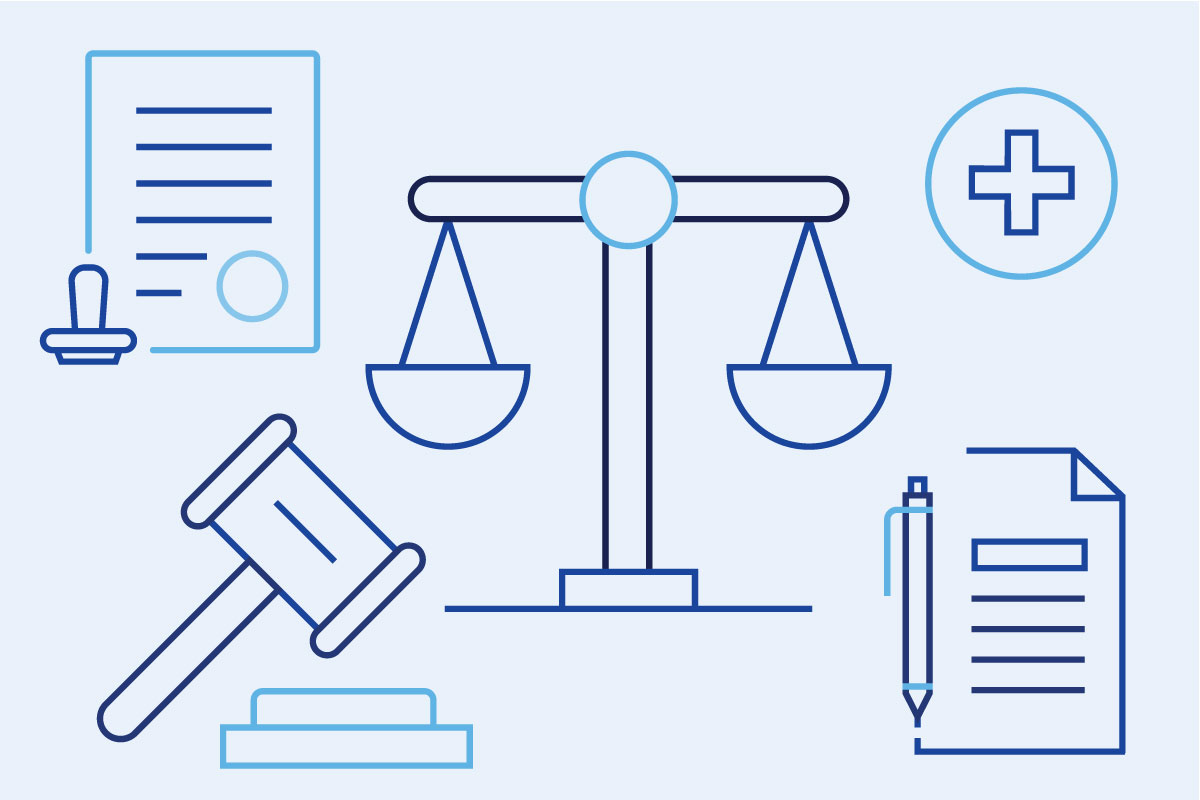Chapter 1
Physical Therapy Spotlight:
Protecting Your License

Healthcare Providers Service Organization (HPSO), in collaboration with CNA, has published our Physical Therapy Professional Liability Exposure Claim Report: 4th Edition. It includes statistical data and case scenarios from CNA claim files, as well as risk manage-ment recommendations designed to help physical therapists and physical therapist assistants reduce their malpractice exposure and improve patient safety.
You may access the complete report, and additional Risk Control Spotlights, at: www.hpso.com/ptclaimreport
This Physical Therapy Spotlight focuses on our analysis and risk recommendations regarding one of the most significant topics in the report: Analysis of License Protection Matters with Defense Expense Payment.
A physical therapist’s (PT) or physical therapist assistant’s (PTA) license is their livelihood, so protecting it is paramount. The practice and conduct of every physical therapy professional are expected to be safe, competent, ethical and in compliance with applicable laws and regulations. Each State Board of Physical Therapy (SBPT) serves as the protector of the public by providing service and leadership in order to promote safe and competent physical therapy practice. The SBPT has the authority to deny an application, discipline a licensed individual, and suspend or revoke a license indefinitely.
When a complaint is asserted, physical therapy professionals must be equipped with the resources to adequately defend themselves. Being unprepared could be the difference between a PT or PTA retaining or losing one’s license. This Physical Therapy Spotlight provides an overview of the role of the SBPT in the legal/regulatory system, describes the disciplinary process, and imparts helpful recommendations on defending yourself in the event that you receive a complaint summons.
The HPSO/CNA Physical Therapy Professional Liability Exposure Claim Report: 4th Edition revealed a total of 170 license defense matters with payment in the five-year analysis, with an average defense expense of $6,420. Compared to the previous dataset, not only has the number of license protection matters in the 2020 dataset increased by 18.1 percent, but the average payment per license defense matter has increased by 33 percent. The following chart represents the 2020 distribution of license protection matters with defense payments by license type. The average total payment represents solely the legal fees and other expenses involved in defending the physical therapy professional against the complaint, rather than fines, or indemnity or settlement payments to a plaintiff. The percentage of license protection matters correlates to the proportion of PTs and PTAs within the overall CNA/HPSO-insured physical therapy population.
License Protection Matters by Licensure Type
Licensure Type
PT
PTA
Total
License protection paid matters
157
13
170
Percentage of license protection paid matters
92.4%
7.6%
100%
Total payments
$ 1,008,511
$82,951
$1,091,462
Average payments
$6,573
$4,583
$6,420
Chapter 2
Understanding the Legal System


There are three types of law, the third of which comes into play during licensing complaints:
Civil Law
Civil Law protects the rights of citizens and offers legal remedies. Civil actions typically involve a plaintiff suing to collect money to compensate for an injury. One example of a civil action is a medical malpractice lawsuit. The outcome of civil cases is deter-mined by which party has the preponderance of evidence in its favor.
Criminal Law
Criminal Law involves the system of legal rules that define conduct that is classified as a crime. Examples include driving under the influence, theft or assault. Criminal cases are deter-mined by proving guilt beyond a reasonable doubt.
Administrative Law
Administrative Law governs the rules and regulations promul-gated and enforced by government agencies – such as your SBPT. Administrative cases are determined by the state providing ‘clear and convincing’ evidence of the allegations, although this standard may vary by state.
The Physical Therapy Practice Act
Each state has enacted laws and issued regulations that govern the conduct of licensed professionals. The law applicable to licensed physical therapy professionals is the state Physical Therapy Practice Act. All physical therapy professionals should become conversant with the PT Practice Act governing the state(s) in which they are practicing. A PT Practice Act is a statute defining the scope and practice of physical therapy within the jurisdiction, outlining licensing requirements for PTs and PTAs, and establishing penalties for violations of the law.
The PT Practice Act gives your SBPT the authority to:
- Provide licensed physical therapy professionals with certain rights and responsibilities;
- Develop practice standards, policies, and administrative rules and regulations;
- Educate physical therapy professionals regarding practice;
- Credential and issue physical therapy licenses; and
- Enforce the laws pertaining to physical therapy practice by investigating reports of professional misconduct and making decisions in order to protect the public.
A PT Practice Act is a statute defining the scope and practice of physical therapy within the jurisdiction.
Licensee Rights During the Complaint and Investigation Process
Should you become the subject of a licensing complaint, the state will not provide a lawyer, or recommend a lawyer, but gives you the right to retain a lawyer. The state also entitles you the opportunity to present evidence to defend yourself during a hearing.
Chapter 3
The Complaint and Investigation Process
Each state has its own complaint and investigation process. This document outlines a typical complaint process.

Any person who has knowledge of conduct by a licensed professional that may violate state or federal law may report the alleged violation to the appropriate state Board, such as the SBPT. Typically, complaints can either be submitted via the state Board’s website or via a form found on the state Board’s website.
After receipt of a signed/dated formal complaint, including a written narrative of “who, what, where, when, how, and to what extent,” the Board’s enforcement staff will determine if the complaint falls within the jurisdiction of the Board’s authority and whether it violates the state’s Code and/or the respondent’s (the licensee who is the subject of the complaint) practice act. Involvement in a disciplinary action will take time to resolve, sometimes years, which can make the entire process all the more stressful for the respondent.
The Disciplinary Process
Complaint Filed
Review of Complaint
Investigation
Board Proceedings
Board Action
Reporting and Enforcements
Investigative Stage
If the complaint is within the jurisdiction of the Board and is allegedly in violation of the law, a member of the enforcement staff will be assigned the matter and may ask for evidence such as: documentation, physical evidence, video, medical records and/or clarification of the information already provided by the complainant. Depending upon the complexity of the complaint, the investigative process may take six months or longer to complete. If you are contacted during the investigative stage, consult with a lawyer. You must be cooperative, but be aware that whatever you share is evidence the investigator will turn over to the Board. Look to your legal counsel for guidance before sharing any information. Your attorney may be able to speak to the investigators, learn more about your case, and help you navigate the entire process.
License Protection vs. Professional Liability
What is the difference?
Difference #1
Inquiry by the State Board, arising from a complaint.
Difference #2
Allegations can be directly related to a physical therapist's clinical practice and professional responsabilities, and they can be of a nonclinical nature, such as physical abuse, unprofessional behavior, or fraud.
Difference #3
The State Board of Physical Therapy can suspend or revoke a license. Its primary mission is to protect the public from unsafe practice.
Difference #1
Civil lawsuit arising from a patient's malpractice claim.
Difference #2
Allegations are related to clinical practice and professional responsabilities.
Difference #3
The civil justice system cannot suspend or revoke your license to practice. Professional liability lawsuits serve to fairly compensate patients who assert that they have suffered injury or damage as the result of professional negligence.
Prosecution Phase
Once the investigation is complete, the prosecuting attorney or state agency will decide how to proceed, of which there are several options:
Allegations
Comprising 59.4 percent of license protection matters, professional misconduct allegations are the most frequent category of allegations asserted against physical therapy professionals in license protection matters. Allegations of physical, sexual, or emotional abuse were the most frequent allegation in the 2020 claim report dataset, comprising 18.2 percent of all license protection matters. Other allegations commonly seen against physical therapy professionals included inappropriate behavior, including misconduct (10.6 percent of license defense matters), unlicensed practice (8.2percent), and fraudulent billing (7.6 percent).
Distribution of License Defense Matters by Primary Allegation Class
Allegations Related to Professional Conduct
18.2%
Physical, sexual, or emotional abuse
10.6%
Inappropriate behavior, including misconduct
8.2%
Unlicensed practice
7.6%
Fraudulent billing
5.9%
Other*
2.9%
Breach of confidentiality or privacy
2.9%
Criminal allegations
2.9%
Practitioner functioning outside of scope of practice
Comparison of 2011, 2016 and 2020 Distribution of State Board of Physical Therapy Actions for PTs and PTAs
2011
2016
2020
44.1%
Matter closed no action
38.2%
47.6%
12.3%
Letter or reprimand
24.3%
14.1%
17.6%
Probation
19.4%
12.9%
5.3%
Consent order or stipulation
2.1%
6.5%
7.1%
Suspension
2.1%
5.9%
0%
Surrender
0%
4.7%
7.1%
Fine
4.2%
3.5%
5.3%
CE
9.0%
2.9%
1.2%
Revocation
0.7%
1.8%
Chapter 4
Risk Management Recommendations
Below are some proactive concepts and behaviors to include in your physical therapy practice, as well as steps to take if you believe you may be involved in a SBPT matter related to your practice:

Everyday practice
- Practicing requirements
- Documenting assessments
- Maintaining files
If regulations and organizational policies differ, comply with whichever is the most stringent or conservative.
Once you become aware of a licensure matter
Immediately contact your professional liability insurance carrier if you:
- Become aware of a filed or potential professional liability matter against you.
- Receive a subpoena to testify in a deposition or trial.
- Have any reason to believe that there may be a potential threat to your license to practice.
- Refrain from discussing the matter with anyone other than your defense attorney or the case professionals managing your case.
- Promptly return calls from your defense attorney and the case professionals. Contact your attorney or case professional before responding to calls, e-mail messages or requests for documents from any other party.
- Provide your insurance carrier with as much information as you can when reporting such matters, including contact information.
- Never testify in a deposition without first consulting your insurance carrier or legal counsel.
- Copy and retain all legal documents for your records, including:
- The summons and complaint
- The subpoena
- Attorney letter(s)
- Any other legal documents pertaining to the matter
License Protection Coverage
Professional liability insurance that includes coverage for license protection safeguards physical therapy professionals against licensing board complaints by

Providing personal protection for inquiries arising out of a covered incident.

Covering costs associated with a disciplinary inquiry, up to $25,000 annual aggregate.

Covered expenses can include legal representation, lost wages and travel.








